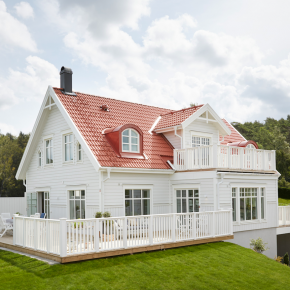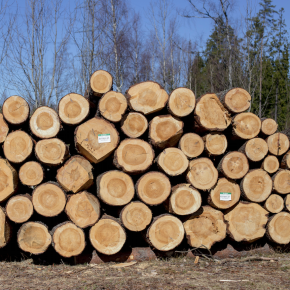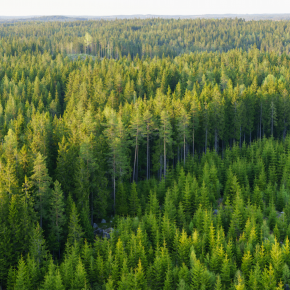
Sodra: Timber – the uniquely renewable building material
 Jeremy English, Sales Director at Södra Wood UK, explains how timber is perfectly placed to meet the needs of the UK construction industry.
Jeremy English, Sales Director at Södra Wood UK, explains how timber is perfectly placed to meet the needs of the UK construction industry.
“With its clean, cost effective, attractive and efficient properties, there’s no doubt that timber has a huge part to play in the future of UK construction. The word about wood is spreading.
It has been dubbed ‘the new concrete’ and ‘a miracle building material’ thanks to its ability to extract carbon from the atmosphere rather than add to it.
Ultimate sustainability
As a uniquely renewable building resource, timber is hard to beat in the sustainability stakes. As they grow, trees absorb harmful carbon dioxide, locking CO2 into the wood forever rather than releasing it into the atmosphere.
Therefore, trees should only be felled when they have fully matured and stopped absorbing CO2 – allowing the environment to fully benefit. And when forests are responsibly managed by owners who put more in than they take out (as Södra’s are), you can be sure the timber you are using has been sustainably harvested.
Embodied energy is the sum of energy required to create a product or service. In the construction industry, this factors in energy expended through building, production and transportation, typically accounting for around 30 – 50% of a project’s entire carbon footprint.

It takes very little energy to convert trees into timber for construction, while the building process typically requires a fifth of the vehicle deliveries demanded by concrete. These factors give timber the lowest embodied energy rating of any mainstream building material.
For example, a wooden floor beam requires around 80 megajoules (mj) of energy per square metre of floor space and emits 4kg CO2.
By comparison, a square metre of floor space supported by a steel beam requires 516mj and emits 40 kg of CO2, while a concrete slab floor requires 290mj and emits 27kg of CO2.
Timber is remarkably strong and durable, guaranteeing no compromise in quality even when speed of construction is taken into account. Timber structures can last hundreds of years and are typically less expensive and easy to maintain than other materials.
Thermal efficiency
The material’s inherent qualities further enhance its green credentials. As a natural insulator, timber contains small air pockets which limit its ability to conduct heat.
This helps minimise the energy needed for heating and cooling homes, which typically leads to less use of fossil fuels. Timber frames also allow more space for insulation than brick constructions, enhancing thermal efficiency.
Efficient offsite manufacture
Offsite manufacture and modular construction are poised to turn UK housebuilding on its head. Fully finished prefabricated timber frame building sections, typically pre-insulated Structural Integrated Panels, are created off-site, in a fabrication facility, and shipped to the site on demand to be fixed together.
Modular homes not only cut construction time by up to half, they also require less labour and materials, which typically reduces cost. Because panels are factory-built, in dry conditions, quality control is exceptional.
Since the structural element is renewable timber, not concrete, block or steel, the carbon footprint is dramatically reduced.

Aesthetically pleasing
The Telegraph has previously reported that the UK needs to build attractive homes ‘that people actually want to live in’. The versatility and inherent natural beauty of timber speaks directly to this.
Timber framing and cladding offers architects, developers and buyers free rein to design – or refine – new homes creatively and sympathetically – without breaking the bank or contradicting local planning requirements.
Timber naturally grows more slowly in colder climates, resulting in tighter growth-rings. This not only signifies stability and strength but also provides an additional design feature. It offers a wide range of aesthetics that give great design flexibility.
It can vary in colours and texture, can be painted in any colour, waxed and varnished, carved, cut, glued and nailed or just left as it is. A timber framed building can be one of the most beautiful types of structure possible.
Timber can also be clad in external materials, allowing it to complement specific local regulations and planning requirements.
A better future – home grown
The construction sector has changed little for decades – but the time for complacency is gone. The government-commissioned Farmer report in 2016 concluded that, unless it changed radically, the British construction industry was ‘a dying patient’.
As the pressure to address the UK’s housing crisis rises, and margins become even tighter, developers and construction companies need to open their eyes to opportunities, efficiencies, quality improvements and savings of sustainable timber-based construction techniques.”
Address: Södra Wood Ltd, Unit 18/19, Cirencester Office Park, Tetbury Road, Cirencester GL7 6JJ
Phone: +44 (0)1285 646000
Fax: +44 (0)1285 646020
Email: [email protected]
Visit Supplier's page
Latest news

26th July 2024
Enfield Speciality Doors completes world-class project for Atlas Copco HQ
A rundown office and warehouse building completely transformed into a modern headquarters for Atlas Copco has been fitted with more than 120 internal fire doors from Enfield Speciality Doors.
Posted in Access Control & Door Entry Systems, Articles, Building Industry News, Building Products & Structures, Building Systems, Case Studies, Doors, Interior Design & Construction, Interiors, Posts, Restoration & Refurbishment, Retrofit & Renovation, Security and Fire Protection, Sustainability & Energy Efficiency, Timber Buildings and Timber Products, Wooden products
26th July 2024
Abloy UK launches new white paper
Abloy UK, a leading provider of security and access control solutions, has launched a new white paper.
Posted in Access Control & Door Entry Systems, Architectural Ironmongery, Articles, Building Industry News, Building Products & Structures, Building Services, Doors, Facility Management & Building Services, Health & Safety, Information Technology, Innovations & New Products, Publications, Research & Materials Testing, Security and Fire Protection
26th July 2024
MCRMA Member Profile: David Roy, Director of Roofconsult
David Roy of MCRMA member company Roofconsult has more than 50 years’ experience to draw upon working in the building envelope sector and a unique perspective on how it has changed in that time.
Posted in Articles, BIM, Infrastructure & CAD Software, Building Associations & Institutes, Building Industry News, Building Products & Structures, Building Services, Building Systems, Cladding, Information Technology, Restoration & Refurbishment, Retrofit & Renovation, Roofs, Walls
26th July 2024
Strand: Enhancing Door Functionality and Safety
Craig Fox, Sales Director for Strand Hardware, outlines how door industry professionals might apply door limiting stays…
Posted in Architectural Ironmongery, Articles, Building Industry News, Building Products & Structures, Building Services, Doors, Facility Management & Building Services, Health & Safety, Restoration & Refurbishment, Retrofit & Renovation
 Sign up:
Sign up: